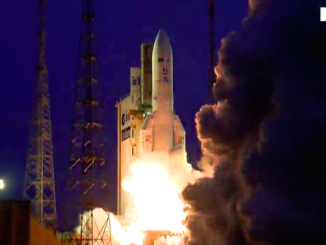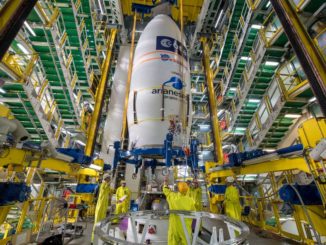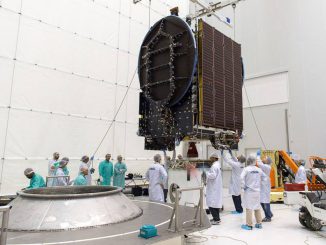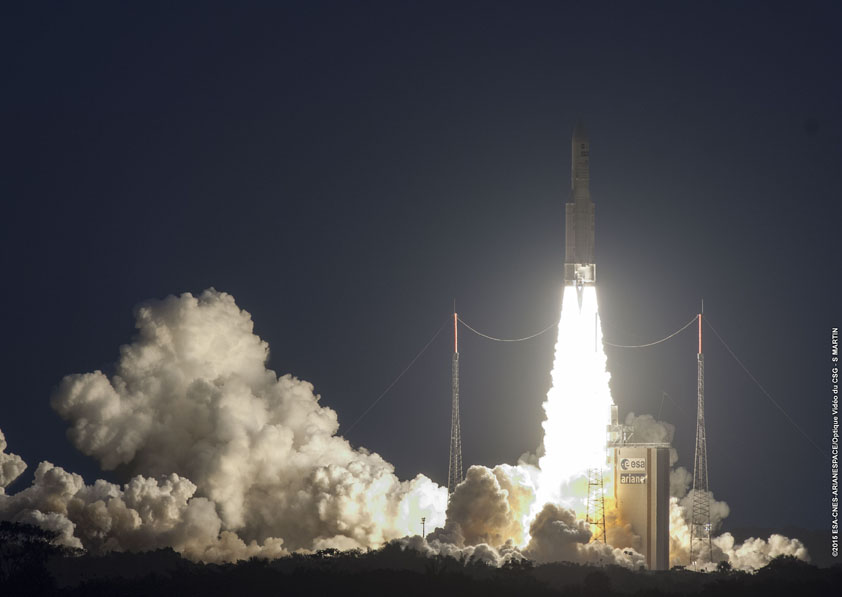
A new spin-stabilized European weather observatory hitched a ride into space aboard an Ariane 5 rocket Wednesday, accompanying a Brazilian television broadcasting craft on a launch from French Guiana into Earth orbit.
The 18-story launcher lit a hydrogen-fueled Vulcain 2 main engine, throttled up to full power and fired twin solid rocket boosters at 2142 GMT (5:42 p.m. EDT), powering the Ariane 5 rocket off its launch pad and east from the Guiana Space Center.
Streaking into the stratosphere, the Ariane 5 surpassed the speed of sound in less than a minute and dropped its two solid rocket boosters at T+plus 2 minutes, 23 seconds.
The Vulcain 2 main engine kept firing until the mission’s nine-minute mark, consuming 705 pounds of super-cold liquid hydrogen and liquid oxygen propellants every second it operated.
An upper stage propelled by a cryogenic HM7B rocket engine finished the job of injecting the Star One C4 and MSG 4 satellites into geostationary transfer orbit.
The rocket’s upper stage released Star One C4 about 28 minutes after liftoff, then jettisoned a cover to expose the MSG 4 spacecraft, which deployed 40 minutes into the flight.
“I am delighted to announce that according to our on-board telemetry systems, Star One C4 and MSG 4 were separated as planned on the targeted optimized geostationary transfer orbit,” said Stephane Israel, chairman and CEO of Arianespace, the Ariane 5’s commercial operator. “Our 80th Ariane 5 has just completed its 66th success in a row.”
Wednesday’s launch was the sixth in up to 12 missions slated this year for Arianespace, and the third flight of 2015 for the Ariane 5 launcher.
“MSG 4 is the last of the second-generation Meteosat satellites, the last in a series, and it is a satellite which will close the gap with the next generation, Meteosat Third Generation,” said Alain Ratier, director general of Eumetsat, operator Europe’s space-based weather observatories.
“We launch it now because we have two aging satellites in orbit, which have exceeded their design lifetimes, and we will store this satellite in orbit to be ready when we need it,” Ratier said.
The 4,504-pound (2,043-kilogram) weather satellite is the fourth and last of Eumetsat’s Meteosat Second Generation spacecraft made by Thales Alenia Space. Eumetsat kicked off the MSG program in 1993, and the first MSG satellite launched in 2002. Officials kept MSG 4, which finished construction in 2007, in storage on the ground for seven years before commencing final launch preparations.
The meteorological sentinel is the last in a breed of spin-stabilized satellites made in Europe, a popular design long used for many communications spacecraft until their replacement with more complicated, heavier three-axis stabilized platforms.
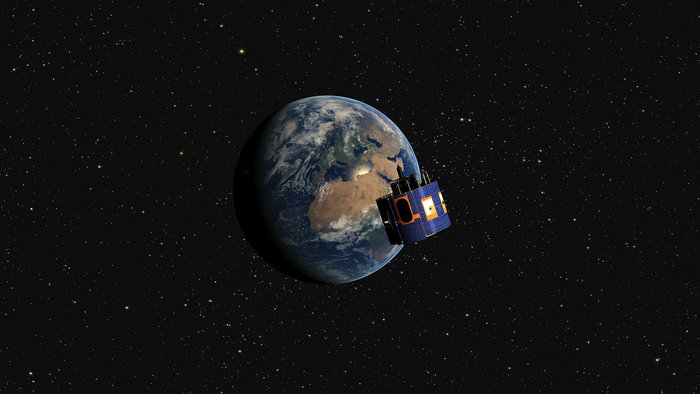
MSG 4 will go into storage for two-and-a-half years before entering service when aging Meteosat birds are retired. Eumetsat expects MSG 4, which will be renamed Meteosat 11 in the coming months, to operate until at least two third-generation Meteosat platforms are in orbit in the early 2020s.
Eumetsat has signed a contract to launch the first two third-generation Meteosat satellites on Ariane 5 rockets in 2019 and 2021, Ratier announced in prepared remarks after Wednesday’s launch. Eumetsat has a contract option for the launch of MTG-3 with Arianespace around 2023.
Before MSG 4, Eumetsat has never launched a weather satellite and put it on standby in orbit. NOAA, the agency’s counterpart in the United States, regularly puts its new weather satellites into in-orbit storage after launch, and Eumetsat’s head said such an approach has cost and risk benefits.
“We will store this satellite in orbit to be ready when we need it,” Ratier said. “It has a big advantage. It saves money because we don’t have to store and de-store on the ground. The satellite is ready, and it also saves risk because when you have a known satellite, and you have to retest it, there are always risks.”
The European Space Agency is in charge of procuring the MSG satellites for Eumetsat, and engineers at the European Space Operations Center in Darmstadt, Germany, picked up signals from MSG 4 shortly after Wednesday’s launch, confirming the spacecraft was healthy.
Ground controllers planned to spin up the drum-shaped spacecraft, then oversee four orbit-raising maneuvers beginning Friday to place the satellite into a circular geostationary orbit nearly 22,300 miles (35,786 kilometers) above Earth’s equator.
Protective covers on MSG 4’s camera will be jettisoned between July 22 and July 25, according to ESA, which will hand over control of MSG 4 to Eumetsat about 12 days after launch for final payload commissioning before going into backup mode in the Meteosat constellation.
MSG 4’s primary instrument, a visible and infrared imaging camera designed to track storms and severe weather, will scan Europe, Africa and other regions once every 15 minutes. It has “rapid scan” capability to track weather systems in Europe with an image once every five minutes, according to ESA.
MSG 4’s co-passenger was the Star One C4 television broadcasting satellite, a 12,268-pound (5,565 kilograms) payload built to beam programming to millions of users across Brazil, Latin America and the United States.
Star One C4 was the 50th spacecraft made by Space Systems/Loral to blast off on an Arianespace rocket. It carries 48 Ku-band transponders for Embratel Star One, a Brazilian operator.
“It becomes part of our fleet of seven satellites with coverage to South, Central and North America, increasing our presence in that region,” said Gustavo Silbert, president of Embratel Star One.”
Embratel plans to put Star One C4 to work in the coming months, in time for video broadcasts of the 2016 Olympics to be held in Rio de Janeiro next year.
The next Ariane 5 launch is set for Aug. 20 with payloads for Eutelsat and Intelsat.
Email the author.
Follow Stephen Clark on Twitter: @StephenClark1.

